Hi! It’s konkaz (@konkazuk) here.
The more you advance in English learning, the more you listen to native pronunciation and analyse it with phonetic symbols.
And at some point, you may start to notice that the small “ッ” in Katakana doesn’t quite fit.
By recognising and adjusting how you handle this “ッ” sound, you can definitely make your English pronunciation better.
So, let’s take a closer look!
Does the small “ッ” in Katakana exist in English pronunciation?
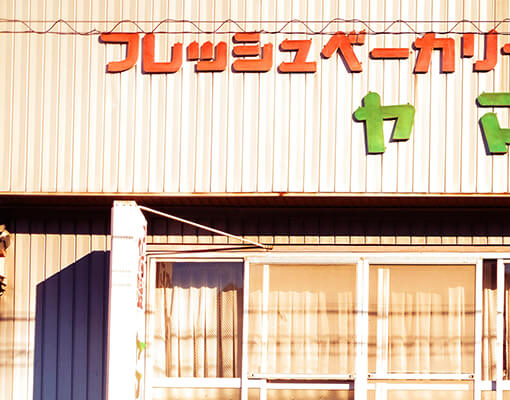
In Japanese, we commonly use the small “っ” [= tsu] in words like “ゆっくり” (slowly), “ちょっと” (a little), and “葉っぱ” (leaf).
This small “っ” is also commonly used in Katakana*, as seen in words like “カップ” (cup), “ラケット” (racket), and “セット” (set).
When pronouncing “cup,” “racket,” or “set” in English, you may still have the presence of “ッ” in your mind.
But is that really how it’s pronounced?
*Katakana characters are used for loanwords in Japan.
What happened when we asked children born in the UK to write Katakana…?

I’ve got a 10-year-old son and an 8-year-old daughter, and since they mostly speak English in their daily lives, their Japanese skills aren’t quite as strong.
They can still speak fairly well, but when it comes to reading and writing, that’s where they struggle the most.
In an effort to improve this situation, I assigned them a task: to write down 20 to 30 words from their Japanese vocabulary that would likely be written in Katakana.
This led to some really interesting findings!
To put it simply, what I discovered is…
the reverse of the struggles we, as Japanese people, face when trying to make our Katakana English pronunciation closer to actual English pronunciation.
In other words…
what emerged was a kind of “pattern” that causes difficulties when converting English pronunciation into Katakana!
When comparing the process of converting
actual English pronunciation ➡︎ Katakana
with the reverse process of converting
Katakana ➡︎ actual English pronunciation,
things that were previously hard to see begin to take shape.
Katakana representations converted from English pronunciation

Please have a look at the image below. This is Katakana written by my children.
Do you recognise what it says?
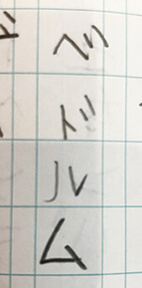

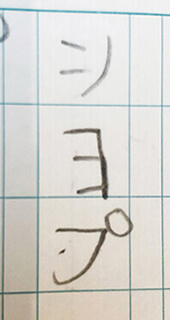
From left to right (or top to bottom on a mobile), it should normally be ベッドルーム (bedroom), フィッシュ (fish) and ショップ (shop), but as you can see,
my children don’t have the small “tsu” (ッ) in their minds!
Now, have a look at the other examples…
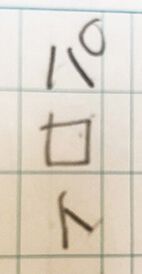
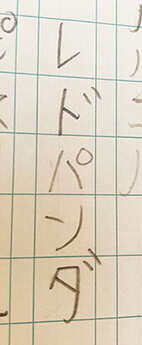
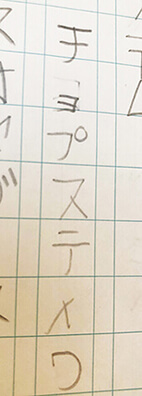
These should normally be パロット (parrot), レッドパンダ(red panda) and チョップスティック (chopstick), but once again, there’s no small ‘tsu‘ (ッ) to be found.
There are many more examples, such as…
アップル(apple) ➡︎ アプル (apuru)
フロッグ (frog) ➡︎ フログ (furogu)
オリンピック(Olympics) ➡︎ オリンピク (Orinpiku)
The list goes on, but in every case, the small ‘tsu‘ (ッ) is missing.

On the flip side, this proves that…
by intentionally dropping the small ‘tsu‘ (ッ) from the katakana vocabulary we use, we can improve our English pronunciation and make it sound more natural.
Actually removing the small ‘tsu’ (ッ)

You’ve probably watched a comedy sketch where Japanese comedians, sometimes in blonde wigs, imitate foreigners speaking Japanese with a strong English accent.
And they typically speak like…
Chottomatte ➡︎ Chotomate
Komatta naa ➡︎ Komata naa
Yappari ➡︎ Yapari
…, don’t they?
Actually, this way of imitating is surprisingly spot-on.
If you look at the phonetic symbols of English words, you’ll see exactly why it makes sense.
Let’s look at the following words as an example.
hit/ pack/ god/ socks/ habit
When converted into Katakana, they turn into…
ヒット/ パック/ ゴッド/ ソックス / ハビット
Now, let’s take a look at the phonetic symbols for these vocabulary words…
[hɪt] / [pæk] / [ɡɒd] / [sɒks] / [hæbɪt]
This time, rather than interpreting these phonetic symbols as familiar ‘katakana words’, if we transliterate them purely based on their sounds in katakana, we get…
ヒト / パク / ゴド / ソクス / ハビト

There are limitations when it comes to representing sounds that end with consonants in katakana, but for the sake of explanation, let’s overlook things like voiceless sounds at this point…
The small “ッ” has disappeared.
How about now?
It’s starting to come together, isn’t it?
Since the small “っ” (or “ッ“) sound doesn’t exist in English, foreign speakers don’t notice it in words like “やっぱり” and “ちょっと” when they speak Japanese.
Now, let’s go back to the phonetic symbols.
Earlier, we wrote
[hɪt] / [pæk] / [ɡɒd] / [sɒks] / [hæbɪt]
as
ヒト / パク / ゴド / ソクス / ハビト
in katakana, but if you look closely, you’ll notice that these phonetic symbols end in consonants.
If we follow the katakana way, we get
[hɪto] / [pæku] / [ɡɒdo] / [sɒkusu] / [hæbɪto],
which requires the light blue parts, but these aren’t present in the actual vocabulary (and certainly not in the phonetic symbols).

Furthermore, to make the consonant parts of the actual vocabulary (or phonetic symbols) clearer (in orange this time),
hit / pack / god / socks / habit
if we write only the parts that can be pronounced in Japanese as katakana, we get
ヒt / パck / ゴd / ソcks / ハビt
The orange parts, which lack vowels, are pronounced by the tip of the tongue touching the gap between the teeth, the throat entrance, or other parts of the mouth, requiring a certain amount of force and momentum, much like striking a match.
Therefore, a very short and subtle gap appears between ‘ヒ‘ and ‘t‘, or ‘ゴ‘ and ‘d‘, but it’s not as long as the small ‘ッ‘ in hiragana.
However, because Japanese has the small ‘っ,’ any gaps felt in words borrowed from foreign languages are filled by inserting the small ‘っ‘ in katakana.
For this reason, subtle differences in pronunciation occur between Japanese and English.
Conclusion: When pronouncing in English, exclude the small ‘tsu’ from katakana.

Therefore, everyone,
when pronouncing English, let’s consciously take out the small ‘tsu’ from the katakana Japanese vocabulary!
And if you get the chance, carefully listen to conversations between native speakers in movies, paying attention to words with the small ‘tsu‘ in katakana.
I’m sure you’ll be like… “Ah, I get it!”
So, that was all about the small ‘tsu‘ in katakana.
Improving katakana English requires some time, but let’s remain patient and work on it little by little.
Until next time,
konkaz
*You can read this blog post in Japanese from the link below.
👉 英語に小さな『ツ』は存在するのか?カタカナ英語の発音を見直す《英語汁 第2号》

